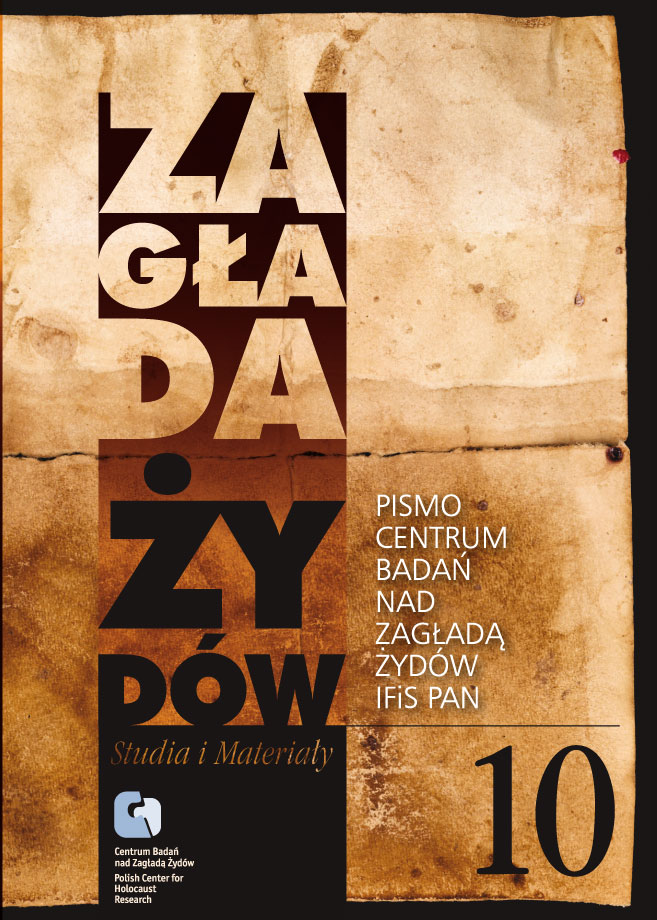Krzesiny i Kreising – między pamiętaniem a pomijaniem. Polskie miasteczko wobec historii, pamięci i rywalizacji w cierpieniu
Zagłada Żydów. Studia i Materiały, Nr 10 (2014), Strony: 443-461
Data zgłoszenia: 2020-10-22Data publikacji: 2014-12-01
 https://doi.org/10.32927/ZZSiM.532
https://doi.org/10.32927/ZZSiM.532
Abstrakt
The area around Krzesiny, located near the city of Poznań, Poland, witnessed several dark events during World War II: Germans oppressed the local population, culminating in a terrorizing action dubbed “akcja krzesińska;” also, a forced labor camp, named “Kreising,” was built near the township, housing mainly Jews. After the war, the suffering in Krzesiny was remembered, but selectively – “akcja” and other forms of Polish suffering were commemorated, while the camp was not. By exploring the “lieux de mémoire” in Krzesiny – dynamics of memory in a small township in Poland – this paper uses localized research to address the issue of gaps in collective memory and commemoration. We briefly look at the relevant history, Polish memory regarding wartime events in Krzesiny, and the postwar dynamics of collective memory. Discussing the latter, we identify a new phenomenon at work, one which we dub “collective disregard” – group neglect of the past of the “Other” that occurs without clear intent. We argue that “collective disregard” is an issue that naturally occurs in the dynamics of memory. By making a deliberate investment in balanced remembrance and commemoration, societies can counter the tendencies of “disregard” and curb the controversies of competitive victimization claims, also called “competitive martyrdom”.
Licencja
Prawa autorskie (c) 2014 Autor & "Zagłada Żydów. Studia i Materiały"

Utwór dostępny jest na licencji Creative Commons Uznanie autorstwa 4.0 Międzynarodowe.
https://creativecommons.org/licenses/by/4.0
Podobne artykuły
- Tomasz Łysak, Yolocaust: kapitalizm platform a cyfrowe praktyki upamiętniania Zagłady , Zagłada Żydów. Studia i Materiały: Nr 17 (2021)
- Karolina Panz, Sieci przetrwania – przemytnicy z Podhala i Spisza w czasie Zagłady , Zagłada Żydów. Studia i Materiały: Nr 18 (2022)
- Aleksandra Bańkowska, Między odpowiedzialnością a bezsilnością, ofiarnością a pokusą. Pracownicy opieki społecznej w getcie warszawskim wobec podopiecznych i petentów , Zagłada Żydów. Studia i Materiały: Nr 20 (2024)
- Adam Kopciowski, David A. Mandelbaum, From Lublin to Shanghai. The Miraculous Exile of Yeshivas Chachmei Lublin, tłum. Malky Heimowitz, New York: Mesorah Publications, 2012, 316 s , Zagłada Żydów. Studia i Materiały: Nr 15 (2019)
- Redakcja, Od Redakcji , Zagłada Żydów. Studia i Materiały: Nr 3 (2007)
- Stephan Stach, „Duch czasu wycisnął jednak na tej pracy swe piętno”. Historia Zagłady w badaniach Żydowskiego Instytutu Historycznego w okresie stalinowskim , Zagłada Żydów. Studia i Materiały: Nr 13 (2017)
- Jan Grabowski, Dariusz Libionka, Bezdroża polityki historycznej. Wokół Markowej, czyli o czym nie mówi Muzeum , Zagłada Żydów. Studia i Materiały: Nr 12 (2016)
- Iwona Kurz, Bartosz Kwieciński, Obrazy i klisze. Między biegunami wizualnej pamięci Zagłady; Katarzyna Mąka-Malatyńska, Widok z tej strony. Przedstawienia Holocaustu w polskim filmie , Zagłada Żydów. Studia i Materiały: Nr 11 (2015)
- Bartłomiej Krupa, Historia krytyczna i jej „gabinet cieni”. Historiografia polska wobec Zagłady 2003–2013 , Zagłada Żydów. Studia i Materiały: Nr 10 (2014)
- Zuzanna Schnepf-Kołacz, Włoski ogród historii. Rzym, Ferrara, Mediolan – nowe projekty na mapie żydowskich muzeów we Włoszech , Zagłada Żydów. Studia i Materiały: Nr 9 (2013)
<< < 1 2 3 4 5 6 7 8 9 10 11 12 13 14 15 16 17 18 19 20 21 22 23 24 25 26 27 28 29 30 31 32 > >>
Możesz również Rozpocznij zaawansowane wyszukiwanie podobieństw dla tego artykułu.
 English
English
 Język Polski
Język Polski








